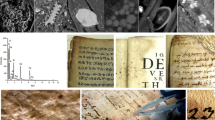Abstract
For the characterization of archaeological ceramics, the study of thin sections under the polarizing microscope is a very efficient analytical technique. There are two properties of ceramics which can be analysed by thin sections, namely the mineralogical composition and the fabric. Both features show a considerable variety which permits a very detailed description of ceramic wares. With respect to the mineralogical composition, there is a wide variety of rock forming minerals, of heavy and ore minerals, fragments of stone, fossils, organic inclusions like straw or pieces of charcoal as well as artificial inclusions like slag or crushed pottery, which define with the temper of the pottery in much detail. The fabric also shows considerable differences in grain size, in the amount of temper, in the orientation of grains and other features, which provide further quantitative data on the properties of archaeological ceramics. From this information, the material can be well characterised, and conclusions as to the region of origin and the potter's techniques can often be drawn.
Similar content being viewed by others
References
el-Hinnawi, E., Methods of Chemical and Mineralogical Microscopy, Elsevier Publishing Company, Amsterdam, London, New York, 1966.
Heinrich, E. W., Microscopic Identification of Minerals, McGraw-Hill, New York, 1965.
Kerr, P. F., Optical Mineralogy, McGraw-Hill, New York, 1977.
Phillips, W. R., Mineral Optics, W.H. Freeman & Co., San Francisco, 1971.
Phillips, W. R. and Griffen, D. T., Optical Mineralogy, the Nonopaque Minerals,W. H. Freeman & Co., San Francisco, 1981.
Saggerson, E. P., Identification Tables for Minerals in Thin Sections, Longman, London, New York, 1975.
Shelly, D., Manual of Optical Mineralogy, Elsevier, Amsterdam, 1975.
Winchell, A. N. and Winchell, H., Elements of Optical Mineralogy, John Wiley and Sons, New York, 1951.
Riederer, J., Ansätze zur Bestimmung der Herkunft kulturgeschichtlicher Keramiken durch mikroskopische Untersuchungen, Veröffentlichungen des Brandenburgischen Landesmuseums für Ur-und Frühgeschichte 19(1995), 249–256.
Riederer, J., The Microscopic Analysis of Egyptian Pottery from the Old Kingdom, Akten des 4. Int. Ägypt. Kongr., München 1985, 1989, pp. 221–230.
Riederer, J., Mineralogische Untersuchung an der Keramik vom Dürrnberg, Dürrnberg-Jahrb. Bd. II, 1974, pp. 169–189.
Riederer, J., Dünnschliffuntersuchungen an rheinischem Steinzeug, In: E. Hähnel (ed.), Siegburger Steinzeug, Köln, 1992, pp. 43–50.
Riederer, J., Die Kalifeldspäte der moldanubischen Granite, Neues Jahrb. Miner., 1965, pp. 291–339.
Riederer, J., Keramologische Untersuchungen an Keramik von Eitzum, In: G. Schwarz-Mackensen (ed.), Die frühbandkeramische Siedlung bei Eitzum, Landkreis Wolfenbüttel, Vol. 45, Veröffentl. Braunschw. Landesmuseum, 1985, pp. 30–36.
Riederer, J., Die mikroskopische Untersuchung von Keramiken aus Zützen, Lkr. Dahme-Spreewald, Veröffentlichungen des Brandenburgischen Landesmuseums für Ur-und Frühgeschichte 30(1996), 121–125.
Riederer, J., Materialanalysen an archäologischen Keramiken aus Brandenburg, Archäologie in Berlin und Brandenburg 1997 (1998), 22–23.
Riederer, J., Die mikroskopische Untersuchung der Keramik, In: Geisler (ed.), Das frühbairische Gräberfeld Straubing-Bajuwarenstraße, 1. Internationale Archäologie, Vol. 30, 1998, pp. 356–357.
Tröger, W. E., Optische Bestimmung der gesteinsbildenden Mineralien, Schweizerbartsche Verlagsbuchandlung, Stuttgart, 1969.
Kappel, I., Die Graphittonkeramik von Manching, In: W. Krämer (ed.), Die Ausgrabungen in Manching, Bd. 2, Franz Steiner Verlag GmbH, Wiesbaden, 1969.
Riederer, J., Private communication.
Hope, C. A., Blauer, H. M. and Riederer, J., Recent Analyses of 18th Dynasty Pottery, In: Studien zur altägyptischen Keramik, Mainz, 1981, pp. 139–166.
Riederer, J., The Microscopic Analysis of Calcite Tempered Pottery from Minshat Abu Omar, Cahiers de la Ceramique Egyptienne 3(1992), 34–37.
Riederer, J., Die mineralogische Untersuchung der römischen Amphoren aus Manching, In: W. E. Stöckli (ed.), Die Grob-und Importkeramik von Manching, Wiesbaden, 1979, pp. 205–213.
Riederer, J., Eine Materialdatenbank antiker Amphoren, Beiträge zur Ur-und Frühgeschichte Mecklenburg-Vorpommerns 35(2000).
Fink, D., Biersack, J. P. and Riederer, J., Messung der Tiefenverteilung offener Poren in Festkörpern, Berliner Beiträge zur Archäometrie 5(1980), 89–95.
Author information
Authors and Affiliations
Rights and permissions
About this article
Cite this article
Riederer, J. Thin Section Microscopy Applied to the Study of Archaeological Ceramics. Hyperfine Interactions 154, 143–158 (2004). https://doi.org/10.1023/B:HYPE.0000032029.24557.b1
Issue Date:
DOI: https://doi.org/10.1023/B:HYPE.0000032029.24557.b1



